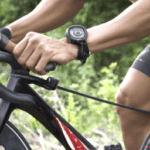Proper breathing techniques can really boost your cycling efficiency. Focus on diaphragmatic breathing to maximize oxygen intake. Try the "three in, three out" exercise to practice, inhaling for three seconds and exhaling for three seconds. Sync your breath with your pedal strokes; for example, inhale for three down-strokes and exhale for six. Keep your posture upright to allow for deeper breaths. Regular practice strengthens your diaphragm and improves your overall performance. You'll find that managing your breath not only enhances endurance but also makes your rides more enjoyable. There's more to discover about this topic to elevate your cycling experience!
Key Takeaways
- Practice diaphragmatic breathing by placing a hand on your abdomen to monitor movement, enhancing oxygen intake and cycling performance.
- Use the "three in, three out" technique to engage your diaphragm, promoting deeper and more efficient breaths during rides.
- Synchronize breathing with pedal strokes, inhaling for 3 down-strokes and exhaling for 6 to maximize oxygen absorption.
- Incorporate controlled breathing patterns to lower heart rate and perceived exertion, especially during intense cycling sessions.
- Regularly monitor your breathing type and rate, ensuring deep breaths are prioritized to improve performance and enjoyment while cycling.
Benefits of Proper Breathing
Proper breathing techniques can greatly enhance your cycling experience and performance. By focusing on breathing efficiency, you're not just taking in air; you're maximizing oxygen delivery to your muscles. This improvement in oxygen intake can considerably boost your endurance on those long rides.
Engaging in deep breathing, particularly through your diaphragm, allows you to expand your lung capacity and absorb more oxygen with each breath. Additionally, staying hydrated is essential for maintaining ideal breathing and performance, as dehydration can lead to reduced lung function and energy levels, similar to the importance of hydration during juice cleanses juice diet considerations.
You'll find that a slower breathing rate—aiming for around 10 breaths per minute—can help lower your heart rate and blood pressure, leading to a more relaxed cycling experience. Techniques like inhaling through your nose and exhaling through your mouth can further improve oxygen absorption and retention, which is vital for ideal performance.
Regularly practicing these breathing techniques can lead to impressive gains in your aerobic capacity, with studies showing improvements of up to 17%. As you integrate proper breathing into your cycling routine, you'll notice enhanced stamina and overall performance, making your rides not only more enjoyable but also more effective.
Techniques for Diaphragmatic Breathing

Techniques for Diaphragmatic Breathing
Diaphragmatic breathing can considerably boost your cycling performance by improving oxygen delivery to your muscles.
Understanding your local gym hours can also be beneficial, as it allows you to schedule your training sessions effectively.
To get started, try placing one hand on your abdomen and focusing on expanding it as you inhale.
Incorporating simple exercises like "three in, three out" can help you master this technique and enhance your endurance on the bike.
Benefits of Diaphragmatic Breathing
Engaging your diaphragm can greatly enhance your cycling performance. When you practice diaphragmatic breathing, your diaphragm contracts fully, allowing for greater lung expansion and improved oxygen intake. This is vital, especially during intense rides when your muscles demand more oxygen.
By taking deep breaths, you can markedly boost your respiratory efficiency, which leads to a reduction in your respiratory rate and increased oxygen delivery to your working muscles. Additionally, focusing on your breath can help you maintain a high vibrational energy during workouts, similar to techniques used in Law of Attraction in Sports and Fitness.
As you incorporate this technique into your cycling routine, you'll likely notice an improvement in your endurance and lung capacity over time. Strengthening your diaphragm and intercostal muscles through regular practice enhances your overall cycling experience. It also helps with rates of perceived exertion (RPE), making your rides feel easier and more enjoyable.
To reinforce proper diaphragmatic breathing, try placing a hand on your abdomen. This way, you can monitor the movement and guarantee your abdomen expands with inhalation instead of your chest.
This conscious effort will lead you to more effective deep breaths, ultimately resulting in better mental focus during your rides. Adopting this technique can take your cycling performance to new heights.
Exercises to Practice Breathing
Improving your breathing techniques can greatly impact your cycling performance, and there are several exercises you can practice to strengthen your diaphragm. Here are some effective breathing exercises to help you master belly breathing:
| Exercise Name | Description | Benefits |
|---|---|---|
| Three in, three out | Exhale for 3 seconds and inhale for 3 seconds. Place your hands on your sternum and abdomen to feel diaphragm movement. | Establishes rhythm and engages diaphragm effectively. |
| Pedal stroke breath | Inhale for 3 down-strokes and exhale for 6. Align your breathing with your cycling rhythm. | Maximizes oxygen intake during cycling. |
| Gradual breath hold | Gradually increase breath hold durations while walking or cycling. | Improves CO₂ tolerance and lung function. |
| Daily belly breathing | Practice belly breathing in daily life to strengthen your diaphragm. | Enhances lung capacity and breathing efficiency while cycling. |
Incorporating these exercises into your training regime can lead to better performance on the bike. Focus on consistency and patience, and soon you'll notice improved breathing efficiency, allowing you to cycle longer and more comfortably.
Integrating Breathing With Cycling
Many cyclists overlook the impact that proper breathing techniques can have on their performance. By integrating your breathing with your cycling rhythm, you can greatly enhance efficiency. For instance, try synchronizing your inhalation and exhalation with pedal revolutions—inhale for three down-strokes and exhale for six. This method helps you maintain focus and promotes a steady oxygen flow.
Additionally, understanding the importance of financial considerations for elderly care can provide peace of mind, allowing you to focus on your cycling without distraction.
Engaging in deep belly breathing while cycling is essential. It allows you to utilize your diaphragm fully, which boosts your oxygen intake and lung capacity. Remember, maintaining an upright posture facilitates diaphragm movement, enabling deeper breaths during your rides.
Additionally, practicing controlled breathing patterns can lower your perceived exertion, making strenuous efforts feel more manageable. This technique is particularly useful during intense rides when anxiety may creep in.
To further improve your breathing, consider incorporating breathing exercises off the bike. Timed inhalation and exhalation drills can develop muscle memory, allowing you to apply these improved breathing techniques seamlessly during your cycling sessions.
As you practice, you'll notice a positive impact on your overall performance and enjoyment of the ride.
Practicing Breathing Exercises

To enhance your cycling performance, practicing specific breathing exercises can make a significant difference. These exercises not only improve your breath control but also increase your lung capacity, allowing you to ride longer and harder.
Here's a quick overview of effective exercises:
| Exercise | Description | Benefits |
|---|---|---|
| Three in, three out | Inhale for 3 seconds, exhale for 3, feeling diaphragm movement. | Enhances breath control |
| Rhythm alignment | Inhale for 3 down-strokes, exhale for 6, focus on audible exhalation. | Syncs breathing with cycling |
| Belly breathing | Expand your abdomen during inhalation to strengthen your diaphragm. | Improves overall efficiency |
Start by integrating the "Three in, three out" technique into your routine. Next, practice aligning your breath with your pedal strokes. Incorporate belly breathing to guarantee you're using your diaphragm effectively.
To simulate altitude training, walk at a normal pace, exhale, hold your breath, and gradually increase your steps. Adjust your breathing pattern based on your terrain and lung capacity—for instance, try inhaling for 2 strokes, holding for 2, and exhaling for 4. This approach not only builds endurance but also maximizes your cycling potential.
Managing Race-Day Anxiety

Race day can stir up anxiety that affects your performance, but you can manage it with effective breathing exercises.
Techniques such as belly breathing and gentle breath-holding not only calm your nerves but also help in maintaining a steady rhythm during your ride.
By incorporating continuous learning and adaptation into your preparation, you'll enhance your focus and resilience.
Practicing these methods will set you up for a more focused and enjoyable race experience.
Breathing Exercises Pre-Race
Feeling anxious before a race is common, but effective breathing exercises can help you manage those nerves. Engaging in deep, rhythmic belly breathing is a great way to stimulate your vagus nerve, calming your pre-race nerves and reducing anxiety. Focus on inhaling deeply for four counts, then exhaling for six counts. This controlled breathing pattern can lower your heart rate, making you feel more relaxed during warm-ups.
Additionally, incorporating a balanced diet leading up to the race may help improve your overall performance and energy levels, as seen in gout nutrition guidelines.
In the moments leading up to the race, try gentle breath holds. For instance, hold your breath for 10-15 paces to stabilize your breathing and enhance your focus. Practicing these techniques in the days leading to the race can improve your ability to handle any anxiety that arises, potentially leading to better performance when it counts.
Utilizing these breathing techniques during warm-ups helps you shift from a state of excitement to one of focused readiness, without overwhelming anxiety getting in the way.
Techniques to Reduce Anxiety
Managing anxiety on race day can be just as important as physical preparation. Utilizing effective breathing techniques can notably help you reduce anxiety and enhance focus. Here are some methods to take into account:
| Technique | Description | Benefits |
|---|---|---|
| Deep Belly Breathing | Engage in slow, deep breaths from your diaphragm. | Lowers heart rate, promotes relaxation. |
| Gentle Breath Holds | Hold your breath for 10-15 paces during warm-ups. | Stabilizes breathing patterns, reduces performance anxiety. |
| Rhythmic Breathing | Maintain a consistent breathing cadence while cycling. | Creates control and readiness. |
| Breathing on the Bike | Apply the above techniques during intense efforts. | Helps maintain focus and manage anxiety. |
| Visualization with Breathing | Combine deep breaths with mental imagery. | Enhances mental readiness and calmness. |
Enhancing Recovery Through Breathing

Effective breathing techniques can play an essential role in enhancing your recovery after cycling. Post-ride, focusing on good breathing helps regulate your heart rate and promotes relaxation. By inhaling deeply, you temporarily increase your heart rate, but it's the exhalation that really counts. Longer exhales can slow your heart rate down, aiding in a more relaxed state and speeding up recovery.
Additionally, understanding the importance of emotional regulation can enhance your focus during recovery, allowing you to manage stress levels effectively, which is vital for overall well-being and performance emotional regulation benefits.
Aim for at least 10 minutes of focused, controlled breathing after your workouts. Engage in deep, slow breaths to lower your respiratory rate and stabilize your heart rate, helping you return to a baseline state more quickly.
Incorporating breath-holding techniques during your cool-down can further enhance CO₂ tolerance, supporting your recovery and boosting endurance for future rides.
Monitoring Breathing Patterns
Monitoring your breathing patterns during cycling is essential for optimizing performance and maintaining comfort on the bike. Regularly check if you're engaging in deep belly breathing or relying on shallow breathing. When you notice yourself shifting to shallow breaths, consciously change to deeper ones. This adjustment can greatly enhance your overall ride experience.
Just as infants develop their motor skills through physical activities, being aware of your breath can also improve your cycling efficiency and stamina, fostering a more enjoyable ride experience baby physical activities encouraging movement.
Pay attention to your breath rate, especially during intense intervals. Rapid breathing is natural, but focusing on the depth of each breath will help maintain your performance. Incorporating timed breathing exercises into your routine can raise your awareness of your breathing patterns and promote more efficient oxygen intake.
To guarantee you're practicing effective belly breathing, place a hand on your abdomen. This technique allows you to monitor diaphragm movement and confirms that you're taking deep breaths rather than shallow ones.
By consistently monitoring your breathing patterns, you'll not only improve your cycling performance but also enjoy your rides more. Remember, the key is awareness—recognizing when your breathing shifts can make a considerable difference in your overall cycling experience.
Frequently Asked Questions
Is It Better to Breathe Through Your Nose or Mouth When Cycling?
It depends on the intensity of your ride. You should breathe through your nose during lower intensity to enhance oxygen delivery, but switch to mouth breathing as the intensity increases for larger air volume.
How to Stop Getting Out of Breath When Cycling?
To stop getting out of breath while cycling, focus on your breathing. Practice diaphragmatic breathing, maintain good posture, and sync your breaths with your pedal strokes to enhance oxygen intake and endurance.
What Is the 3 4 5 Breathing Exercise?
You'd think breathing's simple, right? But the 3-4-5 technique transforms it into an art. Inhale for three seconds, hold for four, exhale for five—this rhythmic dance enhances relaxation and boosts oxygen efficiency. It's powerful!
What Is the 4 4 4 Breathing Exercise?
The 4-4-4 breathing exercise involves inhaling through your nose for four seconds, holding for four seconds, and exhaling through your mouth for four seconds. It helps calm your nerves and enhances your focus.
Conclusion
In the grand scheme of cycling, mastering proper breathing is the key to revealing your full potential. By integrating diaphragmatic techniques and practicing consistently, you'll not only enhance your performance but also recover faster. Don't let race-day anxiety get the better of you; take a deep breath and ride with confidence. Remember, it's not just about putting the pedal to the metal—breathing right can make all the difference in your cycling journey.
















